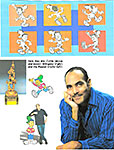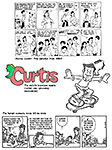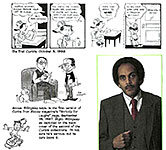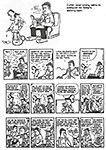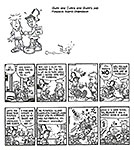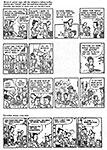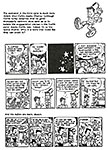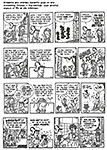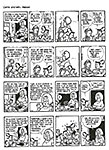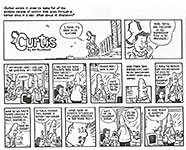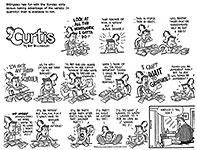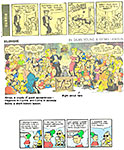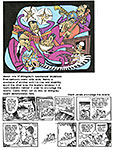 |
|||||||||
Opus 421a (October 22, 2021): Our Bunny Bonus this time celebrates Ray Billingsley’s life and career as the first Black cartoonist to win the Reuben as the National Cartoonists Society’s Cartoonist of the Year. Without further adieu, here we go—:
BILLINGSLEY GETS THE REUBEN First African-American To Be Cartoonist of the Year The National
Cartoonists Society made history on last weekend by presenting Ray
Billingsley, creator of the syndicated comic strip Curtis, with the
Reuben Trophy as Cartoonist of the Year, the cartooning profession’s highest
honor. The coveted award was presented to Billingsley online Saturday evening, October 16, during the finale of NCSFest 2021, the virtual cartooning festival hosted by NCS and the NCS Foundation. (The Reuben Division Awards were also announced; we’ll list them in Opus 423, which will be posted in a week or so.) Filmed accepting the Award at his home studio, Billingsley was just a little flustered at the honor. “Oh my goodness,,” he began, “— I can’t believe this is happening. I can’t believe this has happened. I’d like to thank everyone who made this moment come true, thank everyone from the deepest part of my heart. I never thought I’d see this day.” Choking up and saying he hoped he wouldn’t, Billingsley went on: “This has been a huge step for me. And also a monumental step for the NCS, because I’m the first Black guy to win the prestigious Reuben Award, and for that I am very grateful,” adding, “I wish creators like Morrie Turner and Ted Shearer, and Brumsic Brandon Jr. were here to see this.” The three he named are pioneering Black cartoonists; all, alas, are deceased. And Billingsley went on to name and thank numerous cherished friendships, cartoonists who have helped and guided him—Charles Schulz, Mort Walker, Arnold Roth, Jules Feiffer, Bunny Hoest, and others. (See ncsfest.com for the online virtual NCS Reubens Weekend.) Billingsley, like all syndicated cartoonists, lives a life on deadline all the time, but with Billingsley, that life began earlier than most—at the age of twelve— when he was discovered by KIDS Magazine and hired as a staff artist. After graduating from the High School of Music and Art in Manhattan, he attended the School of Visual Arts on a full four-year scholarship. Upon graduation in 1979, he began an internship at the Walt Disney Studios, but quickly left, having sold his first nationally syndicated comic strip, Lookin’ Fine, which ran from 1980 to 1982 with United Features Syndicate. After that, he spent the next few years working on various projects in the fields of animation, advertising, greeting cards, clothing design, and magazine cartooning, until 1988 when King Features Syndicate bought his Curtis strip and launched it into syndication on October 3. Although he was born (July 25, 1957) in Wake Forest, North Carolina, Billingsley was raised in New York City’s Harlem. It was a time when the citizens were plagued by poor surroundings and drug use. It was his older brother, Richard, who sparked his initial fascination with art and cartooning. As a very young child, Ray learned to draw in order to emulate his brother. “He was really good at portraits, landscapes, and still-lifes,” Ray remembered in telling his life story at his website, billingsleyart.com. “I watched him draw, heard the praises he received from family, school and the church, and one day picked up a pencil. I was seven years old. “As if in some sort of competition with my brother, I practiced and practiced and practiced, and to my family’s surprise, I got better!” Billingsley continued by recounting his debut in professional art. “Recycling was a big deal back in the day. My seventh grade art class was asked to participate in an ecology program. It was our task to construct an 18-foot Christmas tree entirely of recyclable cans in front of a hospital in upper Manhattan. “By this age, I would draw whenever I could, and it had become common for me to carry a small notepad. While they piled up tin cans, I crept away from my classmates, sat nearby and began doodling. It must have been a slow news day because I noticed some news cameras. “A woman approached me and asked to see my drawings. Then, she asked if she could keep a couple, one with my name and phone number on it. A few days later, she actually called on me and my family at home. Turns out, she was an editor at KIDS Magazine, and she wanted me to visit the office to see if I could draw a picture to accompany a certain story. “The office was located on the very busy East Side of New York City and the streets were choked with activity. My mother and I must have looked very out of place, especially with me carrying a portfolio. I made my first sale that very day, and to my surprise, I was offered a job as a staff artist. “I had to show up every day after school—and on Saturday. They made sure I would show up by sending a car for me. So the car would be parked right outside the school, waiting for me to show up. There’s a driver, waiting. And, of course, my classmates, other kids, don’t find that very cool. “In the office, I learned how to do filler and do paste-ups, and I was learning story editing, all that. I’d do sketches, read stories, and finalize drafts for a nationally-recognized magazine. This, along with keeping up my class assignments kept my days filled. I guess I was, more or less, ‘discovered.’ “I stayed with KIDS from age 12 until retiring as an Associate Editor at age 18. My father wasn’t too cool on giving me or my siblings allowances, so drawing became an effective way to make money. Legally, that is. The streets in my neighborhood offered a lot of other ways to make money— a lot of money. Luckily for me, a career was blossoming that I wasn’t even aware of.”
BILLINGSLEY WENT ON WITH his autobiographical recitation: “Art jobs began to take up a lot of my time. In fact, most of it. It wasn’t uncommon for me to work on several projects at the same time, all highly different and commanding different styles. My mother says I used to draw ‘in the air.’ “Trying to have just a normal life, and do what my buddies did was becoming impossible. No one around was into art as I was. They were interested only in things that led to jail, or worse. Playing basketball, fathering children they had no intention of raising, and getting high was the rule. They thought I was weird because I was creative. I thought they were weird because they weren’t. Drawing had become second nature to me and was as easy as breathing. It was all I did. All I knew. “I was accepted into the High School of Music and Art. It was the first time I was around other people my age who shared a desire to carve their own niche in some aspect of the Creative Visual World. It wasn’t always great when I ran up against an art teacher who was still trying to get published, and this lanky Black teenager was doing so regularly. For reasons such as this, and not being accepted by my neighborhood peers, I became somewhat quiet when it comes to my career. I’m still that way.” Among the jobs Billingsley remembers doing was a series of graphic posters for the Path trains and transportation. “They told me they had placed two thousand copies throughout their system, and at the end of a week, only 200 remained. It seems they were being stolen! I felt very flattered. And I wrote and drew a full-color comic book on the Path system, following the adventures of four teenager riders. This was the first time I had to sustain storylines over several pages.” Crazy magazine provided other opportunities to write his own articles, and not just supply art to someone’s script . He sold his first national magazine cartoon spot to Ebony magazine in 1978. “I became, more or less, a regular contributor ’til today. “As I grew, so did my portfolio,” Billingsley said, “— in tearsheets, things that had been published. I was beginning to get the reputation around New York publications as the Kid Artist. I sometimes used my age to my advantage. I remember one interview I went to. “The front office was filled with artists and their portfolios, all angling for the same job. I put on a messenger’s jacket and wore a cap, and put my portfolio in a large envelope. I told the receptionist that I had to give it to the editor personally, or get a signature. Some BS like that. And it worked. When I got in front of that editor, I quickly pulled my portfolio from the envelope and showed it to him. “He looked through the stuff and said, ‘This is yours?’ And I said ‘Yes.’ And he said, ‘You know, you’ve got a lot of chutzpah. I like that. You got yourself in front of me, before everyone else.’ “And he hired me! “By 16, I had become a seasoned pro with a diverse portfolio and steady clients.” Among the other jobs he took on were designs for packaging, art for brochures, a line of greeting cards (“they were popular in Europe”), even a line of designer drawers. The day after graduation from SVA in 1979, Billingsley went to the Disney Studios in Orlando to begin an internship in animation. “It was quite grueling,” he said. “I would draw all day, had mandatory art classes after work, plus I was still working on my own stuff. It was a good thing that I was already used to such a schedule. I learned to draw ‘Disney-Style.’” But his Disney career came to a stop pretty quickly: Billingsley had been working on developing a comic strip, and United Feature Syndicate picked it up.
Lookin’ Fine ran from 1980 to 1982, appearing in 40 to 60 sixty papers. “Above everything,” said Billingsley, “I considered it to be a Great Learning Experience. The problem was I was prevented from doing the strip the way I knew it should be done. It was a strip about an African-American family and I was dealing with solely non-African-American syndicate people. They didn’t have a clue. When it was suggested that to boost sales, this family adopt a White kid, I knew it was time to pack it up and walk away.”
SO HE DID, RETURNING TO FREELANCING and doing well. As long as he continued to be diverse, and able to adapt to whatever the job called for, he was still working. All these antics came to an end in 1988 when Curtis started. Producing a daily-and-Sunday comic strip was a full-time job. In Curtis, Billingsley focused on an urban African American family of four
—father and mother, Greg and Diane Wilkins, Other characters in the strip include Gunk, Curtis’ peculiar friend from Flyspeck Island, sweet Chutney (who adores Curtis), and the egotistical Michelle (whom Curtis adores, but she doesn’t return the sentiment). School bullies Derrick and “Onion” give Curtis a bad time, and strict teacher Mrs. Nelson doesn’t make life at school any easier. In the local barbershop, Curtis has a friend in Gunther the barber, although Gunther never seems to remember the boy’s name.
WHEN BILLINGSLEY AND I TALKED a few years ago, he told me he’d been working on other strip ideas: Curtis was one of several. “I had one called Polly. It was about a fat, lazy parrot who had a really smart mouth. And I started shopping that around. That same year, Garfield started. And when I showed Polly to United Feature, they said, ‘Oh, well, we already have a character that’s fat and lazy and nasty. And more people can relate to a cat than to a parrot.’ “I did another strip called Ma’m, and it was about this Hollywood legend, this woman who had been really big back in the silent era, and she was tryin’ to make a comeback. She was more like BroomHilda, that type of character. She grabbed men, she smoked. She was really raucous. But editors said it was too far over at the time.” He did a take-off on Tarzan. “Wizard of Id—that kind of humor. It was broad slapstick. So I tried a gamut of different things before I came back to Curtis.” “Why,” I asked, “did you decide you were going to go to a Black milieu?” Simple. He followed the aged axiom—Do what you know. “And I knew about being a Black kid,” he said. “I’ve been told that Curtis is actually me the year before I went professional—because Curtis is eleven. I was twelve. “Curtis is actually my middle name,” Billingsley went on. “I did that because of a story Mort Walker told me once about how some guy tried to sue him, saying that Beetle Bailey was his idea—that he had talked to Mort about Beetle Bailey while they were in the service. Come to find out, these two guys weren’t even stationed in the same place, not ever, so he was lying. “So by picking the name Curtis,” he continued, “—I was making sure there’d be no way someone could say, ‘I gave you this idea.’ Because it’s my name.” Billingsley told me about an “inspirational dream” he’d had about Curtis. “I had cartooning in my blood so much that I used to actually dream about different ideas. I would wake up in the middle of the night, and I kept a notepad by my bed. And I’d just jot down a few words and then go back to sleep. “Well, one night, I had a dream idea about this little character, a little Black kid. At the time, it was new for people to wear their ball caps backwards and for them to leave their shirt tails sticking out. And I sat up in bed and drew this character that way. “The next morning, when I woke up and looked at the paper, I had drawn—a quick thing—Curtis. It was very rough. I had to do a lot of smoothing out on him. He and his younger brother Barry came along right away. And then the girls—Michelle and Chutney. They changed a lot. In the first incarnation, Michelle was in love with Curtis, and she was chasing him. And then I thought, ‘H’mmm, that’s too usual. I’m going to make her older than Curtis and have Curtis chase her and have her spurn him.’ “And she’d be the only girl in the cast that had money: everybody else was poor. “Gunk came along last. I needed a character to do things that I can’t do with Curtis. And I thought, ‘I need some odd character who comes from somewhere else.’ And his image and everything, it just came to me. The whole thing about Flyspeck Island. Everything just fit together like a puzzle.” “Such an unusual concept,” I said, “—to introduce this complete fantasy character into a strip that’s grounded very much in reality.” “Right,” said Billingsley. “That’s how I’m able to delve into just about anything I want to do. And King Features gave me that freedom where the other syndicate didn’t. They made me stay with one theme. At least here at King, I could do anything. They had faith in me. And I don’t get bored.”
AT FIRST, THE STRIP was called Curtis and Me, “Me” being Barry. The strip was told from his point of view. He’d be talking about his adventures with his brother, Curtis—which was like Billingsley and his older brother. “But they suggested that I drop it to just Curtis. That way, Barry doesn’t have to be in everything. He doesn’t have to see everything. Another thing—Greg, Curtis’ father, was a single father at first. And one of the themes of the strip was that he was looking for a wife. And the kids, Curtis and Barry, would either bring a woman along as a candidate and they’d try to pair him up, or if they didn’t like the woman, they’d try to sabotage someone he’d met. “But for the time,” Billingsley went on, “syndicate editors thought it was a little too risque. ‘Oh, Curtis needs a mother.’ So I had to introduce her. And I did that after the strip had started. In the first few weeks of Curtis, I only showed the father. I didn’t even know what the mother looked like at that point. “Heck, when the strip first started, I didn’t know what Curtis’ father looked like. I always covered up his face by putting a speech balloon in front of it. Because he wasn’t that important. What he said was important but not what he looked like.” Curtis appears in more than 300 newspapers these days. In an age when print journalism is increasingly threatened, that counts as a big success. Billingsley acknowledges that Wee Pals creator Morrie Turner, the first African-American to bring an interracial cast to national syndication, did indeed open the doors for Curtis and other strips of the genre. And he credits Will Eisner, creator of the masterpiece The Spirit, and also Billingsley’s instructor at SVA, for encouraging him to stretch out artistically. “He always told me to reach out and do more than I thought I could. He was, and still is, a true creative inspiration.” said Billingsley.
BILLINGSLEY WAS INTERVIEWED for the fall/winter 2020 issue of his alma mater’s Visual Arts Journal. Hereafter, we’ve reprinted much of the interview.
Visual Arts Journal: Last summer, you went into New York City to join Black Lives Matter protests in the streets. Did you also find yourself thinking about what you might do in Curtis to respond to this moment? Billingsley: It’s actually always on my mind. Things like this, they affect me personally. So it always translates into my work.
When you started with Curtis, was it your intention to have a strip that would allow you to comment on topical events? When I was first thinking of Curtis back in the 1980s, it wasn’t that kind of platform. But I started drifting into those sorts of stories, and the audience accepted. I knew just doing gags wouldn’t be enough for me. I cannot do a Beetle Bailey, where Beetle gets smashed by Sarge and is back the next day. I can’t have talking cats and dogs and ducks and things like that.
Instead, you have a strip with Curtis’ teacher, Mrs. Nelson, coming down with COVID-19. It was heartbreaking. That storyline really revealed her relationship with Curtis. It is personal to me because she’s a real person. Mrs. Nelson was actually my third-grade teacher. One time she called my mother, and I thought I was in big trouble for something, and she just wanted to tell her about this artistic talent that she saw budding, and she encouraged my mother to push me along.
So in the Mrs. Nelson–Curtis relationship, you’re Curtis? In many ways I was just like Curtis. If something bad happened, everyone in the room would just turn and look at me, because they’d know I did it. I think that actually helped me get through the early days of freelancing. I was a bold young person who didn’t really see boundaries, and that includes all the way up to the School of Visual Arts. Did you have any “Mrs. Nelsons” at SVA? There was Howard Beckerman, Harvey Kurtzman and of course my number one instructor was Will Eisner. And Will Eisner pushed me hard. He knew that I had been published, and when I showed him samples of work, he basically shrugged his shoulders and said, “So what else is there to you?” Then he started teaching me the value of learning different styles and being able to really carry a storyline. Now, Will Eisner always came late into classes he taught. Students were always there before him. So we’d be sitting around, and we’re talking and chatting, and all of a sudden he’d enter the room and there’d be a great hush. If somebody stepped on a marshmallow, you’d have heard it. Will was so strict on us that by the time half of the semester was over, half of the students had transferred out. They just couldn’t take it. Just imagine, you work all night on a project, and the teacher goes, “Eh. Do better.” A lot of people, their egos were a little too big, so they couldn’t take it. But I found it helpful. All experimentation I credit to Will Eisner. He challenged me to step up my game, stretch beyond what he saw as limitations.
What did you learn from Kurtzman? Harvey Kurtzman— he was just crazy. He was eternally making jokes and doing these really funny drawings and he just encouraged humor all the time. His class was really a joy to go to. From the time he came in, he was smiling and laughing.
The journalist Richard Prince once wrote that one reason why Black comic strips are usually about children is that strips with Black adults are seen to be threatening. I found that out the hard way, when I was drawing Lookin’ Fine. I had a chat with Morrie Turner of Wee Pals—he warned me right away, he said, “You’re going to be in trouble.” I spoke about drug use and inequalities in schools and stuff like that. And when you have adults talking about it on a comics page, if you’re next to Ziggy or Nancy or Marmaduke, it’s discomforting. But if a child says the same thing, he can get away with it. All of us were basically learning on our own. We had to learn what worked and what didn’t, and take chances. Morrie Turner doing the first integrated strip, he took a lot of chances. But you can’t please everyone, so you don’t even try. I’m at the point where I’m basically drawing the strip for me, first. This is my world, if you want to come into it, fine. If you don’t, that’s fine, too. [For more about Morrie Turner and Wee Pals, see Harv’s Hindsight for February 2014.)
In one storyline in Curtis, we meet an older Black cartoonist named Quincy Shearer, who tells Curtis about the old days. He’s clearly modeled after Ted Shearer, who created the comic strip Quincy. Did you ever meet Shearer? I never met Ted Shearer and that was unfortunate. I loved the guy’s artwork, his framing, and he was just a master of line. He had a strip where the composition, the panel construction, just drew your eye to it. Usually when a Black artist met another one, they were immediate friends because on some level they know what the other one went through. When I first met Morrie Turner, we went and hugged each other, and he started crying. I said, “What’s the matter?” and he just said, “Congratulations.” And then we just sat and talked. Another older cartoonist was Samuel Joyner. He told me a lot of the stories about cartooning during the time of blackface cartoons. Joyner told me he had to have a white friend bring his work to the editor to try to sell it. There were a lot of startling revelations to this man's experiences. [We’ll offer a glimpse in our next opus.—RCH]
What was the main lesson that Joyner taught you? Creativity at any cost. It’s not the money. It’s the need to express yourself and hope that people will like it. He did not seem to be bitter about anything.
Do you ever hear from readers who are unhappy about something in Curtis? Sometimes it’s the smallest thing you can think of. If I mention a lot of rap music, somebody will complain. I had Curtis eating Rapper Puffs, a cereal, and some people didn’t like that. If someone gets upset at a box called Rapper Puffs, there’s a low threshold out there.
Did you feel a pressure, from yourself or others, to represent a certain kind of Black life in Curtis? Yes, there is definitely a pressure but moreover a pressure to maintain a good standard. I have to have more hits than misses. One of the things that was important was a strong Black family unit. In my strip, Curtis is the only one who enjoys a two-parent household. One of the other characters lives with his grandmother; he doesn’t even know where his parents are. A couple times I’ve even had Curtis’ father say, “Curtis, this isn’t one of those strips where the kid outthinks the parent.”
How did you decide Curtis’ personality, what kind of kid he would be? Charles Schulz was a friend. He was like a father figure to me. I was sort of messing with him at one point, I said, “Lucy is the loudmouth, Schroeder plays the piano, what does Franklin do? He doesn’t even get angry at anyone. He’s just a good guy.” And Schulz didn’t really have an answer. I knew what Schulz was trying to do. We had the marches, we had the assassination of Malcolm X, and he decided to bring along a very nice character. But that’s what I tried to get away from. Curtis can be mischievous. It even goes to the way he’s dressed. Curtis made his debut in ’88, and in ’88 you were considered to be a little troublesome if you wore your hat backwards, if you let your shirt come out under your sweater. Curtis did all that way back then when it meant something. And unlike other characters, he had no problems when talking to girls.
What are the challenges for Black cartoonists starting out today? A lot about the industry isn’t really that inspiring. I don’t have a book deal. I have one company that actually told me that Blacks really don’t read, and they insinuated that Whites wouldn’t buy books about Blacks. So we’re still at that. No merchandise nor animation deals—nothing. Despite my decades-old success, I still feel overlooked, like I have to continually prove myself. It really bothers me. [Curtis has been reprinted in three volumes so far, all parts of The Curtis Chronicles series: A Boy Named Curtis (Vol.1, strips from 2000), Living on Spongecake (Vol.2, 2001), and Friends, Family & Other Catastrophes (Vol.3, 2002)—all 154 8.5x11-inch landscape pages, b/w; $20.95 (including $3.99 shipping and handling) at Billinsley’s website. I suspect that The Curtis Chronicles is a Billingsley-funded project.—RCH] One thing I hear from Black cartoonists is that when they are trying to sell a comic strip with Black characters to newspapers, the paper’s editors will say, “We already have Curtis.” It’s not fair. I’m not the voice. Every voice is different and every voice is welcome. When Baby Blues was coming out, nobody said we already have Hi and Lois. It doesn’t work that way. But it’s the hardest thing to break. I’m really nobody’s role model. Robb Armstrong, he has a very good strip, his main character is a policeman, very different. Keith Knight has a strip out that’s very different. Barbara Brandon-Croft had a syndicated strip, Where I’m Coming From, written from an African American point of view. There is also Darrin Bell, who won a Pulitzer for editorial cartoons. [Bell also produces two syndicated daily-and-Sunday strips, Candorville and Rudy Park. —RCH] We need people like that. Throughout the web, we see a lot of Black voices, women and men. They can’t sell what they have to say, but with the Internet, they can at least express it. They can have their individual stories told, their own voices and creative experiences.
What do you see as the future for Curtis? As long as there is some sort of craziness going on in society, I can bring that into the strip. Which is why the strip has survived for so long.
CURTIS IS A FULL-TIME JOB, and Billingsley is a perfectionist, working from his second-floor studio in his Stamford, Connecticut home. He balances his life with his family, the few whom he considers real friends, and his faithful companion Higgins the Basset Hound. Billingsley is low-key and somewhat reclusive, enjoys music and the simple things in life. He still studies, reads classic strips, and likes to travel and explore life (although he hates the hassle of travel, and has a little fear of flying) and is a very good chef. In
producing Curtis, Billlingsley has adopted a traditional cartoony style.
He is capable of some wildly inventive artwork, but for storytelling, a certain
restraint pays off. In the strip, he deploys a bold line for outlining figures,
adding detail with discerning thin strokes. The result is that his characters
take possession of every panel, their feet firmly in place. Curtis is a very human comic strip. It deals in the basic aspects of life in a city as experienced by real people. Billingsley’s figures are gentle exaggerations of actual people but well this side of the “big foot” manner. (While it’s true that Curtis has big feet, it’s actually his shoes that are big, and their size is a satirical comment on teenage fashions.) (Or so it sez rightcheer.) Billingsley’s cartoony approach permits him to explode visuals into wild fantastic pictures that boost the action—and, hence, the comedy. Drawing from real life, Billingsley blends domestic humor with sometimes startling commentary on topics such as racism and guns in school. And last year, Billingsley became one of the first cartoonists to create a storyline addressing the COVID-19 pandemic when Curtis learned that his teacher was in the hospital with the illness. Educators and community leaders have praised Billingsley for his thought-provoking and straight-forward handling of such serious social and health issues as drug abuse, crime and asthma. And when Curtis and Barry adopt a crack baby, Billingsley got a lot of mail—mostly positive. The story began simply enough. One day, the boys’ mother notices that milk is disappearing faster than it usually does. “I just bought milk yesterday,” she says, “—but it’s gone.” Curtis notices Barry behaving suspiciously, and when Barry takes some milk out of the house, Curtis follows him. Barry goes down into a nearby basement. Curtis thinks he’s feeding a cat down there, but it isn’t a cat. It’s a baby. Barry had wrapped the infant up in blankets and he was feeding the baby the milk he took from his family refrigerator. “The mother wasn’t there,” Billingsley said during our conversation. “Once Curtis found out about the baby, he brought his parents in on it, and then the authorities got involved. The police searched for the mother, and when they found her, they saw that she was a crack addict. And so the baby was put into foster care and adopted by a real family. “And that was a big whoop-de-doo for the time,” he went on. “No one had done anything about crack at all. Child abandonment, things like that—had not been attended to.” “What kind of responses did you get?” I asked. “Oh, I got a lotta positive stuff,” Billingsley said. “More positive than negative. And I did get negative mail—along the lines of, ‘This shouldn’t be in a comic strip. This should be a newspaper article’—something like that. I take it for what it’s worth, negative mail. It may have a little bit of truth in it. So I listen.” He also listened to the positive reactions. But through all of the ensuing controversy, Billingsley felt he was right to do the story. “It’s what I felt at the time,” he told me. “It’s what I felt the strip needed to do. I didn’t want the strip to be about Curtis living in the city and everything is wine and roses—because rarely was it ever. It was a tough time growin’ up in the city, and that was my experience that I wanted to bring into the strip.” He insisted that the strip be an honest reflection of life in the big city—and of life in general. “Even my core characters, the Wilkins family, they’re not the happiest people all the time,” he said. “I mean, they get into arguments. People have told me that Curtis has been very realistic in the fact that he argues with his parents, and they argue back at him, and they threaten him. And people say, ‘Oh, you can’t do that. Parents can’t do that.’ “Of course they can,” Billingsley said. “Parents can do that, and they should do that. It makes the kids become better citizens. I’m not saying that they should out-and-out whip the kids. But what they should do is teach them some sort of discipline. My parents were great believers in discipline,” he laughed. “That sort of realism—and the crack baby episode—was the sort of thing I had to put in the strip. The crack baby episode was just what was goin’ on at the time. The Black community was decimated by crack. I knew a lot of people who had great jobs, great futures. I’d see them one day, and then see them three months later, and they were begging in the streets because crack had taken them over. So I just felt compelled to do something on it in the strip.” Billingsley also played with the rap industry. “At one point,” he said, “rap was so controversial that each time a rapper came out, it led to a congressional summit, you know. They were saying that ‘You can’t say this, you can’t say that.’ So I had a good time with rap. “There was a record store in the strip, and each time Curtis would visit, it was in a different location. It was under a different name. And it was selling this rap music that had been banned by everybody.” The store moved around a lot because every time parents learned where it was, they burned it down. “And some of my readers were upset by that,” Billingsley said. “They said, ‘Oh, well, you can’t do that. That’s arson.’ I’m like, ‘That’s not the point, that’s not the idea I’m trying to put across.’ But I got enough positive reinforcement to keep it going.” In the interest of imparting a certain realism to the strip, Billingsley has had President Barack Obama show up occasionally. Curtis and Barry attend Obama’s inauguration ceremony, and when it’s over, Barry has disappeared. Curtis spends several days looking for Barry. He is found, finally, by President Obama, who discovers that his daughters have a new playmate—Barry. For several years, Billingsley has participated in Kwanzaa in the strip, often developing a historical storyline and deploying a different drawing style. Kwanzaa is an African-American celebration that occurs during the Christmas holidays, usually between December 26 and December 31st. And Curtis also recognizes Black History Month every year. Billingsley’s passion for authenticity in the strip has earned him both awards and praise from interested parties. In recognition of his storyline in which Curtis tries to get his father to quit smoking, Billingsley has received numerous awards and recognition from the American Lung Association, including the President's Award in 2000 during the American Lung Association/Canadian Lung Association conference in Toronto, Canada. First given in 1983, the President's Award was created to acknowledge an individual, or nonprofit or commercial organization, responsible for an outstanding contribution in an area of importance to the goals of the American Lung Association. In addition, Billingsley received the Humanitarian Award from the American Lung Association of Southeast Florida in 1999. And now, the Reuben. Gratifying though such awards are, Billingsley, like most cartoonists, draws his comic strip because he loves cartooning. The satisfaction it yields is award enough. “I’m still here to inspire others,” Billingsley says, “— inspire them to forge ahead with their own dreams and to push themselves beyond the boundaries of the status quo. It would be wonderful if Curtis were to be pushed out into the public eye like Peanuts or Garfield, but I don’t see it happening. At least not right now. But maybe one of my students will make the change happen.”
To find out about Harv's books, click here. |
|||||||||

send e-mail to R.C. Harvey Art of the Comic Book - Art of the Funnies - Accidental Ambassador Gordo - reviews - order form - Harv's Hindsights - main page |
